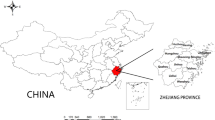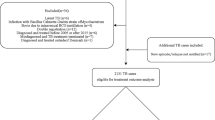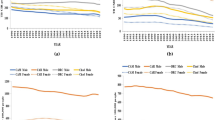Abstract
After COVID-19, tuberculosis (TB) is the leading cause of death by an infectious disease in the world. This work presents a data set based on data collected from the Brazilian Information System for Notifiable Diseases (SINAN) for the period from January 2001 to April 2020 relating to patients diagnosed with tuberculosis in Brazil. The data from SINAN was pre-processed to generate a new data set with two distinct treatment outcome classes: CURED and DIED. The data set comprises 37 categorical attributes (including socio-demographic, clinical, and laboratory data) as well as the target class. There are 927,909 records of patients classified as CURED and 36,190 classified as DIED, totaling 964,099 records.
Similar content being viewed by others
Background & Summary
Tuberculosis is an airborne infectious disease caused by the bacillus Mycobacterium tuberculosis; globally it is the second largest cause of morbidity and mortality by an infectious agent1,2. Historically, there has been a significant global effort to reduce the death rate of tuberculosis. However, these efforts have been compromised due to the COVID-19 pandemic. Brazil has one of the highest incidences of tuberculosis worldwide and is among the 22 countries considered by World Health Organization (WHO) as having a high burden of tuberculosis3,4. In 2019, Brazil registered 96,000 cases of the disease, with a mortality rate of 7.00%04.
The elimination of tuberculosis is a global priority, as evidenced by its inclusion in the Sustainable Development Goals. Central to reducing the transmission of TB and ultimately the elimination of TB is early identification of TB-infected patients, application of infection-control measures, and early enrollment in treatment5. To this end, WHO has called for intensified research and innovation to improve early diagnosis, shorten and provide more effective treatment regimens, improve prevention, and partners for cross-sectoral actions5.
The clinical management of tuberculosis relies on the medical assessment of clinical and diagnostic information. Data on relapse, co-infection, and severity can be crucial to decide on procedures as pharmacological and clinical interventions. Timely intervention is vital to control the spread of the disease, and the patient’s prognostis and ultimate outcome. However, predicting a patient’s prognosis is a complex task as tuberculosis has different treatment outcomes depending on the type of TB6. Answering the WHO call for innovation in early diagnosis, extant literature has proposed the application of artificial intelligence techniques, such as machine learning and deep learning models, to support the speed and efficacy of tuberculosis treatment decision-making, and specifically prognosis.
The Brazilian Information System for Notifiable Diseases (Sistema de Informação de Agravo de Notificação or SINAN) from the Brazilian Ministry of Health collects and stores data on each disease incidence of a notifiable disease in Brazil. This data is routinely generated by the Epidemiological Surveillance System. SINAN has a database with socio-demographic, clinical, and laboratory data on suspected tuberculosis cases that can be used to generate multiple analyses for public health planning and the assessment of disease prognosis. However, most machine learning and deep learning models applied in the literature for the treatment of tuberculosis require labeled data, that is, they contain information about what is being classified. This work presents an extension of the SINAN database that includes outcome data (i.e. “CURED” or “DIED”) for the period January 2001 to April 2020. The availability of such data enables researchers to create training and test data sets, and use this data to build, evaluate, and optimise machine learning models to support the prognosis of tuberculosis in patients. Also, other outcomes regarding treatment adherence and relapses are available and can be assessed. A high-level epidemiological analysis of the data set is also presented.
Methods
The original data was collected from the Information System for Notifiable Diseases (Sistema de Informação de Agravos de Notificação7) for the period from January 2001 to April 2020 including data from all 26 Brazilian states and the Federal District (Brasília) of Brazil. It contains socio-demographic, clinical and laboratory data about patients who were diagnosed with tuberculosis. While the SINAN-TB database is public, certain data is labeled sensitive and is protected by the General Law for the Protection of Personal Data Brazil (Lei Geral de Proteção de Dados Pessoais or LGPD). Such sensitive data is only available upon request to SINAN’s ethics committee. The data used in this research does not contain any such sensitive information.
The SINAN data set was cleaned using a variety of preprocessing techniques as outlined in Fig. 1. The original data set comprised 1,712,205 records and 88 attributes. Following preprocessing, 748,106 rows and 50 fields were removed resulting in a final preprocessed data set of 964,099 records and 38 attributes.
Tables 1–4 shows all the attributes removed in the preprocessing process. These attributes were removed for different reasons including the column featuring primarily empty values (‘NaN’); attributes starting with the nomenclature ‘ID’; attributes starting with ‘DT’ with the exception of ‘DT_NOTIFIC’ and ‘DT_NASC’; attributes irrelevant to the tuberculosis context (such as ‘BENEF_GOV’, ‘TRANSF’, ‘NU_LOTE’ and ‘NU_TELEFON’); replacement fields with ‘NaN’ values, by 9 (others), since step two did not eliminate all ‘NaN’ values; removal of lines with different values from ‘1’ (CURED class) and ‘3’ (DIED class) from the attribute ‘SITUA_ENCE’; removal of lines with ‘DT_NOTIFIC’, ‘DT_ENCERRA’ and ‘DT_NASC’ with ‘NaN’ values; calculation of the number of days that the patient spent in treatment using ‘DT_NOTIFIC’ and ‘DT_ENCERRA’ and add new attribute called ‘DIAS_EM_TRATAMENTO’; attributes removed by authors’ discretion/analysis, as well as duplicate data and attributes.
Data Records
The original and preprocessed data set, as well as the English data dictionary, are available at the Mendeley Data repository and can be accessed via the link (https://doi.org/10.17632/fkpfd5b9n9.5)8.
Figure 2 presents the number of records in the data set by year and by prognosis (records labelled as CURED and DIED) in Brazil between January 2001 and April 2020. It is important to note that the year 2020 has relatively fewer records as the data set only includes records up to April 2020. In addition, SINAN notifications were adversely affected by the COVID-19 pandemic2. The highest number of DIED cases was in 2017 (3,099) and the highest number of CURED cases was in 2018 (61,839).
Figure 3 presents the number of records in the data set by age group and by treatment outcome (records labelled as CURED and DIED). Most cases of tuberculosis are among patients 20 to 60 years old, with the highest number of CURED (412,723) in the 20 to 40 age group, and the highest number of DIED (14,349) between 40 and 60 years old.
Figure 4 presents heat maps of the cases of tuberculosis by Brazilian regions between January 2001 and April 2020, while Fig. 5 shows the cases of DIED by region in the same period. The Southeast region, comprising the states of São Paulo (SP), Minas Gerais (MG), Espírito Santo (ES), and Rio de Janeiro (RJ) had the highest incidence of tuberculosis with 345,491 cases (records labelled as CURED and DIED); it also had the highest number of deaths (14,215) over the 19 years. With 51,878 cases, the Midwest region was the region with the lowest number tuberculosis cases and lowest number of deaths (1,697). The state with the highest number of tuberculosis cases was Rio de Janeiro (RJ) with 168,495 tuberculosis cases and 7,912 deaths. The state with the lowest incidence of tuberculosis was Roraima (RR), in the North region, with 2,413 cases of TB. The state with the lowest incidence of deaths is Amapá (AP) with 61 registered deaths Table 5.
The final data set had 39 attribute grouped in to the three categories - socio-demographic (as presented in Table 5), clinical, and laboratory based on9,10. As can be seen in Fig. 6, clinical data was further categorised into comorbidities, drugs, and other.
Table 6 shows the attributes grouped as clinical data for comorbidities such as diabetes, AIDS and others. Drugs administered to patients during tuberculosis treatment were grouped as clinical data as per Table 7.
Only two clinical attributes were labelled “Other” as per Table 8: the clinical form of tuberculosis (labelled as “FORMA”) and the type of health unit admission (labelled as “TRATAMENTO”) for the patient containing: new case, recurrence, re-entry after abandonment, don’t know, transfer and post-death.
The laboratory attributes were generated from the results of tests performed in the laboratory such as X-ray, HIV serology result, tuberculin skin test etc, and were grouped as shown in Table 9.
Supplementary Table 1 lists all attributes described with their appropriate characteristics. Males had the highest number of records labelled as CURED and DIED; females had a mortality rate almost three times lower than men (26.40%). Only 6.00% of tuberculosis cases had an AIDS-associated disease and 6.80% of patients tested positive for HIV. The most widely administered drugs were Rifampicin and Isoniazid, both with 67.00% of CURED cases, although 50.20% of patients who died from the disease also took these drugs. The drugs with a low administration rate were Streptomi and Ethionamide with only 0.80% and 0.90% of the total number of patients taking these medications, respectively. The pulmonary clinical form of tuberculosis represents 84.60% of all cases. Patients who died from tuberculosis spent an average of 56 days in treatment while those cured spent 211 days in treatment.
Technical Validation
All data presented in this work can be corroborated by reports published by the Brazilian Ministry of Health.
Usage Notes
This data set can serve as the basis for researchers to develop, evaluate, and optimise machine learning and deep learning models to predict treatment outcomes and support health professionals in the diagnosis, prognosis, treatment and control of tuberculosis. As a result, the burden on already overstretched health systems and economies, particularly those in disadvantaged regions around the world, can be reduced by accelerating the restoration. Furthermore, making data available enables researchers worldwide to carry out individual patient data meta-analysis and thereby generating more robust evidence on clinical and public health.
Code availability
The code used to pre-process the data set is publicly available on GitHub and is accessible through the link: https://github.com/dotlab-brazil/tuberculosis_preprocessing.
References
Pai, M. et al. Tuberculosis. nature reviews disease primers, 2, 16076 (2016).
WHO. Global tuberculosis report 2021. https://apps.who.int/iris/rest/bitstreams/1379788/retrieve. Accessed: 2022-09-20 (2021).
WHO. Country profiles for 30 high tb burden countries. https://www.who.int/tb/publications/global_report/tb19_Report_country_profiles_15October2019.pdf?ua=1. Accessed: 2022-09-21.
WHO. Tuberculosis profile: Brazil. https://worldhealthorg.shinyapps.io/tb_profiles/?_inputs_ lan=%22EN%22 iso2=%22BR%22. noteAccessed: 2022-09-21.
Organization, W. H. et al. Fact sheet on sustainable development goals (sdgs): Health targets. World Health Organization: Geneva, Switzerland (2018).
Organization, W. H. Definitions and reporting framework for tuberculosis – 2013 revision: updated December 2014 and January 2020 (World Health Organization, 2013).
SINANWEB. Sistema de informação de agravos de notificação. http://portalsinan.saude.gov.br/. Accessed: 2021-12-06.
Lino Ferreira da Silva Barros, M. H., Santos, G., Sampaio, V., Lynn, T. & Endo, P. T. A brazilian classified dataset for prognosis of tuberculosis. Mendeley Data https://doi.org/10.17632/fkpfd5b9n9.5 (2022).
Boffo, M. M. S., Mattos, I. G. D., Ribeiro, M. O. & Oliveira Neto, I. C. D. Tuberculosis associated to aids: demographic, clinical and laboratory characteristics of patients cared for at a reference center in the south of brazil. Jornal Brasileiro de Pneumologia 30, 140–146 (2004).
da Silva Neto, S. R. et al. Arboviral disease record data-dengue and chikungunya, brazil, 2013–2020. Scientific Data 9, 1–11 (2022).
Acknowledgements
This work was partially funded by Conselho Nacional de Desenvolvimento Científico e Tecnológico (CNPq), Coordenação de Aperfeiçoamento de Pessoal de Nível Superior (CAPES), Fundação de Amparo à Ciência e Tecnologia do Estado de Pernambuco (FACEPE), Fundação de Amparo à Pesquisa do Estado do Amazonas: Pro-Estado grant 005/2019 and POSGRAD 2022/2023, and Universidade de Pernambuco (UPE), an entity of the Government of the State of Pernambuco focused on the promotion of teaching, research, and extension. V.S.S. was funded by Fundação de Amparo à Pesquisa do Estado do Amazonas (PRODOC/FAPEAM). P.T.E. and V.S.S. are funded by CNPq - Productivity.
Author information
Authors and Affiliations
Contributions
M.H.L.F.S.B., G.L.S. and M.G.A.R. conceived the experiments. M.H.L.F.S.B., G.L.S. and M.G.A.R. conducted the experiments. M.H.L.F.S.B. and G.L.S. developed the experiment code. V.S. and P.T.E. revised the data set M.H.L.F.S.B., V.S., T.L. and P.T.E. analysed the results. All authors wrote and reviewed the manuscript.
Corresponding author
Ethics declarations
Competing interests
The authors declare no competing interests.
Additional information
Publisher’s note Springer Nature remains neutral with regard to jurisdictional claims in published maps and institutional affiliations.
Supplementary information
Rights and permissions
Open Access This article is licensed under a Creative Commons Attribution 4.0 International License, which permits use, sharing, adaptation, distribution and reproduction in any medium or format, as long as you give appropriate credit to the original author(s) and the source, provide a link to the Creative Commons license, and indicate if changes were made. The images or other third party material in this article are included in the article’s Creative Commons license, unless indicated otherwise in a credit line to the material. If material is not included in the article’s Creative Commons license and your intended use is not permitted by statutory regulation or exceeds the permitted use, you will need to obtain permission directly from the copyright holder. To view a copy of this license, visit http://creativecommons.org/licenses/by/4.0/.
About this article
Cite this article
Lino Ferreira da Silva Barros, M.H., Santos, G.L., de Almeida Rodrigues, M.G. et al. A Brazilian classified data set for prognosis of tuberculosis, between January 2001 and April 2020. Sci Data 9, 771 (2022). https://doi.org/10.1038/s41597-022-01892-4
Received:
Accepted:
Published:
DOI: https://doi.org/10.1038/s41597-022-01892-4









